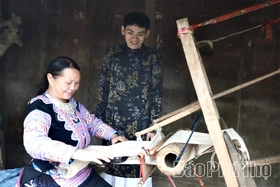{title}
{publish}
{head}
Phu Tho, known as the ancestral land of Vietnam, is not only the cradle of the Worship of Hung Kings—an intangible cultural heritage of humanity recognized by UNESCO—but also a vibrant mosaic of unique cultural traditions from ethnic groups such as the Muong, Dao, and Thai. Following the administrative merger with Hoa Binh and Vinh Phuc, the province’s cultural foundation has been significantly enriched, becoming a vital driving force for the rise of the local tourism industry.

After the merger of three provinces—Hoa Binh, Phu Tho, and Vinh Phuc—Phu Tho has emerged as a locality embodying the core cultural values of the Vietnamese nation.
According to Resolution No. 1676/NQ-UBTVQH15 issued by the National Assembly Standing Committee, the new Phu Tho Province was officially established on July 1, 2025. This marked the beginning of a unified region that integrates and preserves Vietnam’s most essential cultural legacies across thousands of years of history.

It is this cultural depth that has become the foundation for Phu Tho’s growing prominence on the national tourism map.
A report by the Department of Culture, Sports and Tourism on post-merger heritage inventory reveals that the province now boasts 4,758 cultural heritages, including 2,778 heritage sites spanning various types—historical, architectural, archaeological, and scenic. Among these are six special national relics, including Hung Kings Temple Historical Site, Tay Thien Scenic Complex, Binh Son Tower, Tho Tang Communal House, Huong Canh Communal House Complex, and the prehistoric caves of Hang Xom Trai and Mai Da Lang Vanh. The province is also home to 176 nationally-ranked relics and 797 provincially recognized sites. In terms of intangible cultural heritage, there are 1,980 entries across seven categories, with 41 of them listed as National Intangible Cultural Heritage. Notably, Xoan singing and the Worship of Hung Kings have been honored by UNESCO as Representative Intangible Cultural Heritage of Humanity.

The integration of Hoa Binh culture adds unique value to the ancestral land.
As the cultural cradle of the Vietnamese people, Hoa Binh—now a part of Phu Tho—is home to invaluable heritages such as hundreds of bronze drums, nearly 10,000 ceremonial gongs, and the epic Mo oral traditions of the Muong people. This region is recognized for five national intangible cultural heritages, including Mo Muong, the Art of Muong Gongs, the Spring Festival (Khai Ha), Bamboo Calendar Knowledge, and the Rituals and Beliefs of Keng Loong practiced by the Thai people in Mai Chau.

Hoa Binh continues to be regarded as a cultural convergence zone with a rich tapestry of traditional ethnic identities.
In the first half of 2025, the newly merged Phu Tho Province (including all three former provinces) welcomed over 9.3 million visitors, a 10.5% increase year-on-year. Cultural and historical destinations—such as Hung Kings Temple, Hung Lo Ancient Village, Hung Vuong Museum, and ethnic community villages of the Muong, Dao, and Thai—saw visitor numbers rise by nearly 18%. These statistics affirm cultural tourism as a promising direction for sustainable development.
Immediately after the merger, Phu Tho Province launched an action program to implement Directive No. 34/CĐ-TTg dated April 10, 2025, from the Prime Minister on boosting tourism development and ensuring double-digit economic growth. A clear strategy was set: to promote sustainable tourism centered on culture, ecology, and community.
To realize this vision, the province has supported the organization of dozens of training courses for tour guides and developed model community-based tourism sites in Mai Chau, Lac Son, Thanh Son, Tam Nong, and Yen Lap. Notably, the province is collaborating with the Ministry of Culture, Sports and Tourism to prepare a UNESCO nomination dossier for the Art of Muong Gongs, aiming for international recognition as a Representative Intangible Cultural Heritage of Humanity. This effort will serve as a new lever for enhancing Phu Tho’s cultural tourism profile on the global stage.
Manh Hung

baophutho.vn On December 8, 2017, at its 12th session, the UNESCO Intergovernmental Committee for the Safeguarding of Intangible Cultural Heritage...

baophutho.vn Situated in the fertile land of Binh Nguyen (Vinh Phuc), the Huong Canh Communal House Complex — comprising Huong Canh, Ngoc Canh and Tien...

baophutho.vn For generations, whenever people mention Huong Canh Town (former Binh Xuyen District, Vinh Phuc Province), now Binh Nguyen Commune of Phu Tho...

baophutho.vn Kha Cuu Commune was formed by merging three former communes: Dong Cuu, Thuong Cuu, and Kha Cuu, with the Muong ethnic group accounting for over...

baophutho.vn Perched atop Tram Linh Hill, Quoc Te Temple in the former Di Nau Commune — now Tho Van Commune — has long been regarded as a solemn and...

baophutho.vn Located in Giap Lai Commune, this ancient communal house is revered by local residents as the “soul of the Muong village.” It is dedicated to...

baophutho.vn The Thai people are the largest indigenous ethnic group in Mai Chau District, now residing mainly in communes such as Mai Chau, Bao La, Mai Ha,...

baophutho.vn Today, Phu Tho Province is home to hundreds of traditional craft villages — from wood carving, blacksmithing, and bamboo weaving to mechanics,...

baophutho.vn In line with the orientation toward tourism-based economic development, the traditional brocade weaving craft of the Mong ethnic group in Pa Co...

baophutho.vn On the morning of October 25, the opening ceremony of the Mien Doi Terraced Fields Festival 2025 took place in Thuong Coc Commune.